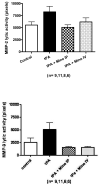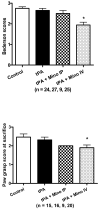Minocycline and tissue-type plasminogen activator for stroke: assessment of interaction potential
- PMID: 19628804
- PMCID: PMC2754038
- DOI: 10.1161/STROKEAHA.109.556852
Minocycline and tissue-type plasminogen activator for stroke: assessment of interaction potential
Abstract
Background and purpose: New treatment strategies for acute ischemic stroke must be evaluated in the context of effective reperfusion. Minocycline is a neuroprotective agent that inhibits proteolytic enzymes and therefore could potentially both inactivate the clot lysis effect and decrease the damaging effects of tissue-type plasminogen activator (t-PA). This study aimed to determine the effect of minocycline on t-PA clot lysis and t-PA-induced hemorrhage formation after ischemia.
Methods: Fibrinolytic and amidolytic activities of t-PA were investigated in vitro over a range of clinically relevant minocycline concentrations. A suture occlusion model of 3-hour temporary cerebral ischemia in rats treated with t-PA and 2 different minocycline regimens was used. Blood-brain barrier basal lamina components, matrix metalloproteinases (MMPs), hemorrhage formation, infarct size, edema, and behavior outcome were assessed.
Results: Minocycline did not affect t-PA fibrinolysis. However, minocycline treatment at 3 mg/kg IV decreased total protein expression of both MMP-2 (P=0.0034) and MMP-9 (P=0.001 for 92 kDa and P=0.0084 for 87 kDa). It also decreased the incidence of hemorrhage (P=0.019), improved neurologic outcome (P=0.0001 for Bederson score and P=0.0391 for paw grasp test), and appeared to decrease mortality. MMP inhibition was associated with decreased degradation in collagen IV and laminin-alpha1 (P=0.0001).
Conclusions: Combination treatment with minocycline is beneficial in t-PA-treated animals and does not compromise clot lysis. These results also suggest that neurovascular protection by minocycline after stroke may involve direct protection of the blood-brain barrier during thrombolysis with t-PA.
Figures









Similar articles
-
Delayed minocycline inhibits ischemia-activated matrix metalloproteinases 2 and 9 after experimental stroke.BMC Neurosci. 2006 Jul 17;7:56. doi: 10.1186/1471-2202-7-56. BMC Neurosci. 2006. PMID: 16846501 Free PMC article.
-
Extension of the thrombolytic time window with minocycline in experimental stroke.Stroke. 2008 Dec;39(12):3372-7. doi: 10.1161/STROKEAHA.108.514026. Epub 2008 Oct 16. Stroke. 2008. PMID: 18927459 Free PMC article.
-
Normobaric hyperoxia reduces the neurovascular complications associated with delayed tissue plasminogen activator treatment in a rat model of focal cerebral ischemia.Stroke. 2009 Jul;40(7):2526-31. doi: 10.1161/STROKEAHA.108.545483. Epub 2009 May 28. Stroke. 2009. PMID: 19478225 Free PMC article.
-
Repurposing an old drug to improve the use and safety of tissue plasminogen activator for acute ischemic stroke: minocycline.Pharmacotherapy. 2010 Jul;30(7 Pt 2):55S-61S. doi: 10.1592/phco.30.pt2.55S. Pharmacotherapy. 2010. PMID: 20575623 Free PMC article. Review.
-
Role of tissue-type plasminogen activator in ischemic stroke.J Pharmacol Sci. 2010;113(3):203-7. doi: 10.1254/jphs.10r01cp. Epub 2010 Jun 29. J Pharmacol Sci. 2010. PMID: 20595786 Review.
Cited by
-
Soluble TNF receptor 1-secreting ex vivo-derived dendritic cells reduce injury after stroke.J Cereb Blood Flow Metab. 2013 Sep;33(9):1376-85. doi: 10.1038/jcbfm.2013.100. Epub 2013 Jun 12. J Cereb Blood Flow Metab. 2013. PMID: 23756688 Free PMC article.
-
Angiogenesis in old-aged subjects after ischemic stroke: a cautionary note for investigators.J Angiogenes Res. 2010 Nov 26;2:26. doi: 10.1186/2040-2384-2-26. J Angiogenes Res. 2010. PMID: 21110846 Free PMC article.
-
Minocycline for acute stroke treatment: a systematic review and meta-analysis of randomized clinical trials.J Neurol. 2018 Aug;265(8):1871-1879. doi: 10.1007/s00415-018-8935-3. Epub 2018 Jun 14. J Neurol. 2018. PMID: 29948247
-
Effects of minocycline plus tissue plasminogen activator combination therapy after focal embolic stroke in type 1 diabetic rats.Stroke. 2013 Mar;44(3):745-52. doi: 10.1161/STROKEAHA.111.000309. Epub 2013 Feb 19. Stroke. 2013. PMID: 23422086 Free PMC article.
-
Tissue plasminogen activator-based clot busting: Controlled delivery approaches.Glob Cardiol Sci Pract. 2014 Oct 16;2014(3):336-49. doi: 10.5339/gcsp.2014.46. eCollection 2014. Glob Cardiol Sci Pract. 2014. PMID: 25780787 Free PMC article. Review.
References
-
- Tissue plasminogen activator for acute ischemic stroke. The National Institute of Neurological Disorders and Stroke rt-PA Stroke Study Group. N Engl J Med. 1995;333(24):1581–1587. - PubMed
-
- Hacke W, Kaste M, Bluhmki E, Brozman M, Davalos A, Guidetti D, Larrue V, Lees KR, Medeghri Z, Machnig T, et al. Thrombolysis with alteplase 3 to 4.5 hours after acute ischemic stroke. N Engl J Med. 2008;359(13):1317–1329. - PubMed
-
- Ning M, Furie KL, Koroshetz WJ, Lee H, Barron M, Lederer M, Wang X, Zhu M, Sorensen AG, Lo EH, et al. Association between tPA therapy and raised early matrix metalloproteinase-9 in acute stroke. Neurology. 2006;66(10):1550–1555. - PubMed
-
- Rosenberg GA, Navratil M, Barone F, Feuerstein G. Proteolytic cascade enzymes increase in focal cerebral ischemia in rat. J Cereb Blood Flow Metab. 1996;16(3):360–366. - PubMed
-
- Heo JH, Lucero J, Abumiya T, Koziol JA, Copeland BR, del Zoppo GJ. Matrix metalloproteinases increase very early during experimental focal cerebral ischemia. J Cereb Blood Flow Metab. 1999;19(6):624–633. - PubMed
Publication types
MeSH terms
Substances
Grants and funding
LinkOut - more resources
Full Text Sources
Medical
Miscellaneous

